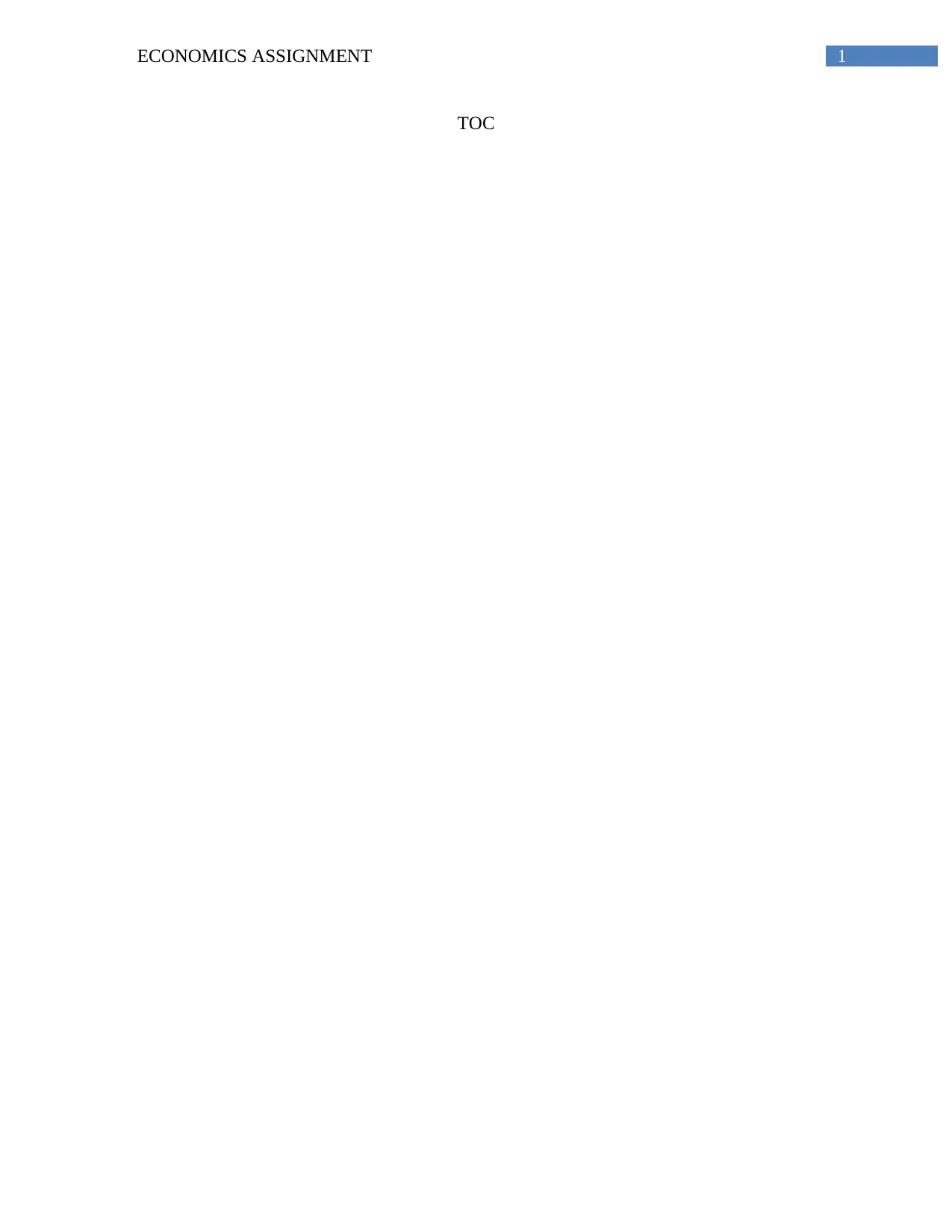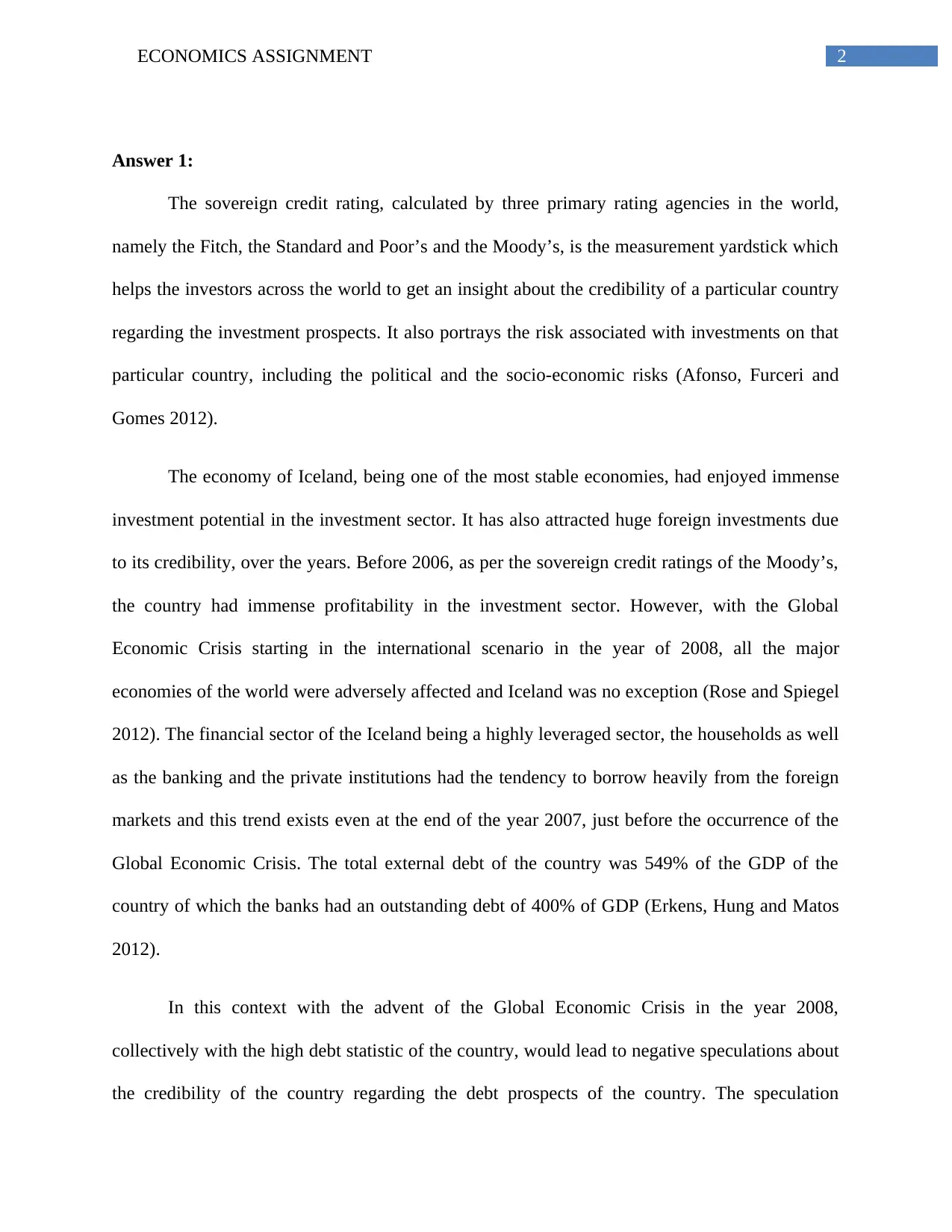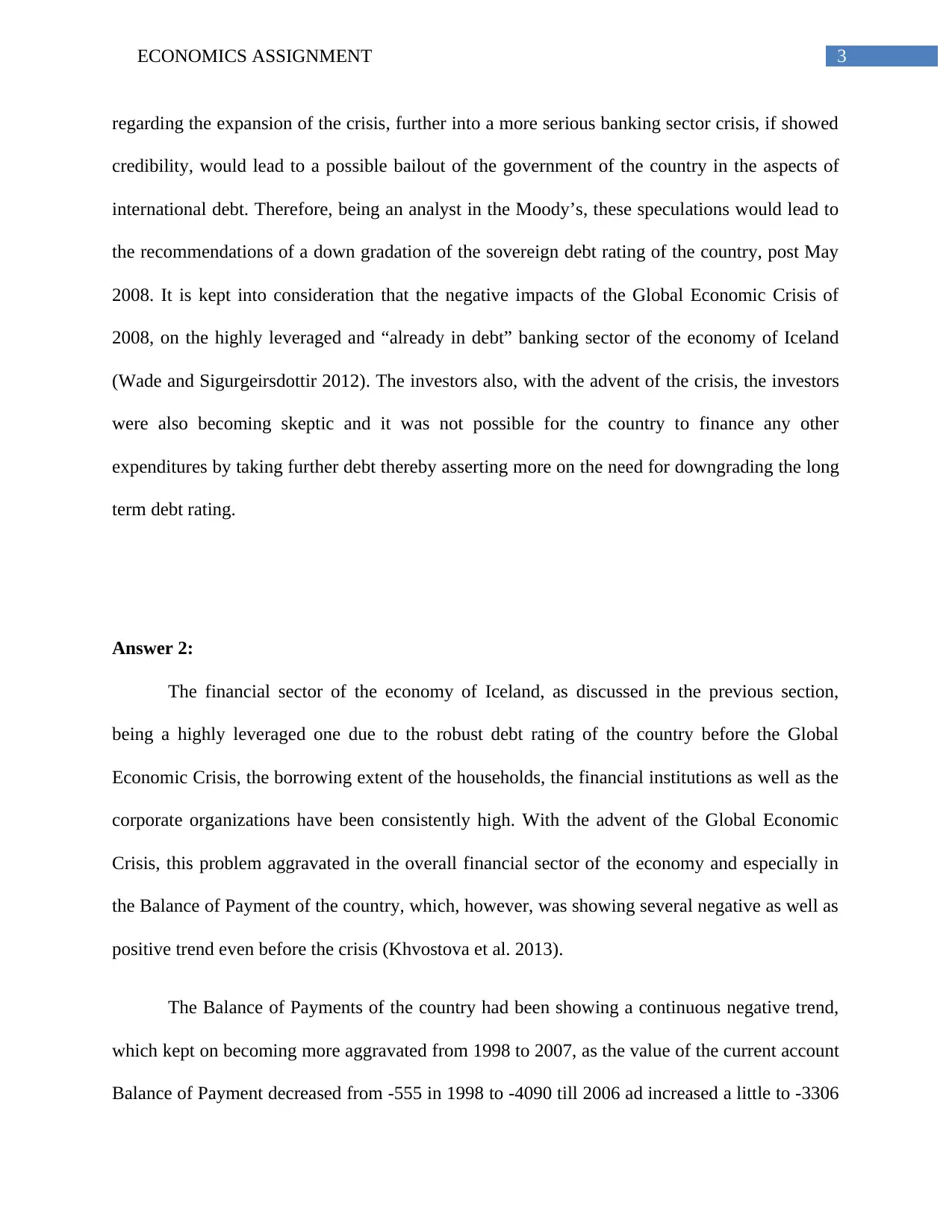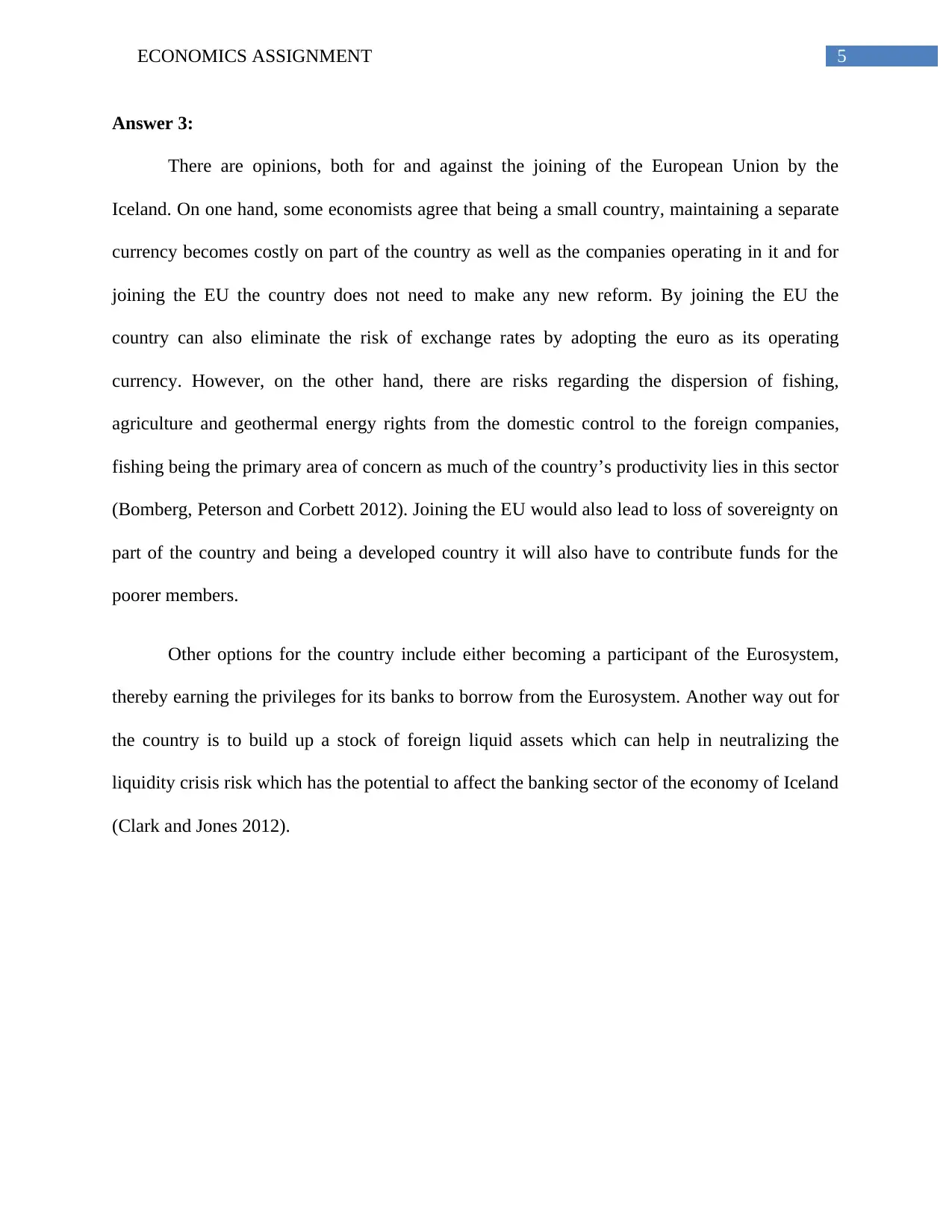Economics Assignment: Analysis of Iceland's Economic Challenges
VerifiedAdded on 2020/05/11
|7
|1537
|52
Report
AI Summary
This economics assignment analyzes the economic crisis experienced by Iceland, focusing on its sovereign credit rating, balance of payments, and the potential implications of joining the European Union. The assignment examines the factors contributing to the crisis, including the highly leveraged financial sector and significant external debt. It explores the negative trends in Iceland's balance of payments, including the impact of carry trade and the decline in the capital and financial accounts. The assignment also discusses the arguments for and against Iceland's EU membership, considering factors such as currency, fishing rights, and loss of sovereignty. The analysis draws on various academic sources to provide a comprehensive understanding of Iceland's economic challenges and potential solutions.

Running head: ECONOMICS ASSIGNMENT
Economics Assignment
Name of the Student
Name of the University
Author Note
Economics Assignment
Name of the Student
Name of the University
Author Note
Paraphrase This Document
Need a fresh take? Get an instant paraphrase of this document with our AI Paraphraser

1ECONOMICS ASSIGNMENT
TOC
TOC

2ECONOMICS ASSIGNMENT
Answer 1:
The sovereign credit rating, calculated by three primary rating agencies in the world,
namely the Fitch, the Standard and Poor’s and the Moody’s, is the measurement yardstick which
helps the investors across the world to get an insight about the credibility of a particular country
regarding the investment prospects. It also portrays the risk associated with investments on that
particular country, including the political and the socio-economic risks (Afonso, Furceri and
Gomes 2012).
The economy of Iceland, being one of the most stable economies, had enjoyed immense
investment potential in the investment sector. It has also attracted huge foreign investments due
to its credibility, over the years. Before 2006, as per the sovereign credit ratings of the Moody’s,
the country had immense profitability in the investment sector. However, with the Global
Economic Crisis starting in the international scenario in the year of 2008, all the major
economies of the world were adversely affected and Iceland was no exception (Rose and Spiegel
2012). The financial sector of the Iceland being a highly leveraged sector, the households as well
as the banking and the private institutions had the tendency to borrow heavily from the foreign
markets and this trend exists even at the end of the year 2007, just before the occurrence of the
Global Economic Crisis. The total external debt of the country was 549% of the GDP of the
country of which the banks had an outstanding debt of 400% of GDP (Erkens, Hung and Matos
2012).
In this context with the advent of the Global Economic Crisis in the year 2008,
collectively with the high debt statistic of the country, would lead to negative speculations about
the credibility of the country regarding the debt prospects of the country. The speculation
Answer 1:
The sovereign credit rating, calculated by three primary rating agencies in the world,
namely the Fitch, the Standard and Poor’s and the Moody’s, is the measurement yardstick which
helps the investors across the world to get an insight about the credibility of a particular country
regarding the investment prospects. It also portrays the risk associated with investments on that
particular country, including the political and the socio-economic risks (Afonso, Furceri and
Gomes 2012).
The economy of Iceland, being one of the most stable economies, had enjoyed immense
investment potential in the investment sector. It has also attracted huge foreign investments due
to its credibility, over the years. Before 2006, as per the sovereign credit ratings of the Moody’s,
the country had immense profitability in the investment sector. However, with the Global
Economic Crisis starting in the international scenario in the year of 2008, all the major
economies of the world were adversely affected and Iceland was no exception (Rose and Spiegel
2012). The financial sector of the Iceland being a highly leveraged sector, the households as well
as the banking and the private institutions had the tendency to borrow heavily from the foreign
markets and this trend exists even at the end of the year 2007, just before the occurrence of the
Global Economic Crisis. The total external debt of the country was 549% of the GDP of the
country of which the banks had an outstanding debt of 400% of GDP (Erkens, Hung and Matos
2012).
In this context with the advent of the Global Economic Crisis in the year 2008,
collectively with the high debt statistic of the country, would lead to negative speculations about
the credibility of the country regarding the debt prospects of the country. The speculation
⊘ This is a preview!⊘
Do you want full access?
Subscribe today to unlock all pages.

Trusted by 1+ million students worldwide

3ECONOMICS ASSIGNMENT
regarding the expansion of the crisis, further into a more serious banking sector crisis, if showed
credibility, would lead to a possible bailout of the government of the country in the aspects of
international debt. Therefore, being an analyst in the Moody’s, these speculations would lead to
the recommendations of a down gradation of the sovereign debt rating of the country, post May
2008. It is kept into consideration that the negative impacts of the Global Economic Crisis of
2008, on the highly leveraged and “already in debt” banking sector of the economy of Iceland
(Wade and Sigurgeirsdottir 2012). The investors also, with the advent of the crisis, the investors
were also becoming skeptic and it was not possible for the country to finance any other
expenditures by taking further debt thereby asserting more on the need for downgrading the long
term debt rating.
Answer 2:
The financial sector of the economy of Iceland, as discussed in the previous section,
being a highly leveraged one due to the robust debt rating of the country before the Global
Economic Crisis, the borrowing extent of the households, the financial institutions as well as the
corporate organizations have been consistently high. With the advent of the Global Economic
Crisis, this problem aggravated in the overall financial sector of the economy and especially in
the Balance of Payment of the country, which, however, was showing several negative as well as
positive trend even before the crisis (Khvostova et al. 2013).
The Balance of Payments of the country had been showing a continuous negative trend,
which kept on becoming more aggravated from 1998 to 2007, as the value of the current account
Balance of Payment decreased from -555 in 1998 to -4090 till 2006 ad increased a little to -3306
regarding the expansion of the crisis, further into a more serious banking sector crisis, if showed
credibility, would lead to a possible bailout of the government of the country in the aspects of
international debt. Therefore, being an analyst in the Moody’s, these speculations would lead to
the recommendations of a down gradation of the sovereign debt rating of the country, post May
2008. It is kept into consideration that the negative impacts of the Global Economic Crisis of
2008, on the highly leveraged and “already in debt” banking sector of the economy of Iceland
(Wade and Sigurgeirsdottir 2012). The investors also, with the advent of the crisis, the investors
were also becoming skeptic and it was not possible for the country to finance any other
expenditures by taking further debt thereby asserting more on the need for downgrading the long
term debt rating.
Answer 2:
The financial sector of the economy of Iceland, as discussed in the previous section,
being a highly leveraged one due to the robust debt rating of the country before the Global
Economic Crisis, the borrowing extent of the households, the financial institutions as well as the
corporate organizations have been consistently high. With the advent of the Global Economic
Crisis, this problem aggravated in the overall financial sector of the economy and especially in
the Balance of Payment of the country, which, however, was showing several negative as well as
positive trend even before the crisis (Khvostova et al. 2013).
The Balance of Payments of the country had been showing a continuous negative trend,
which kept on becoming more aggravated from 1998 to 2007, as the value of the current account
Balance of Payment decreased from -555 in 1998 to -4090 till 2006 ad increased a little to -3306
Paraphrase This Document
Need a fresh take? Get an instant paraphrase of this document with our AI Paraphraser

4ECONOMICS ASSIGNMENT
in 2007. Apart from that the balance of payments of the expenditures also continually kept on
decreasing within the period with the number decreasing from -298 in 1998 to -5528 in 2007.
These two becoming most worrisome aspects of the Balance of Payment, there were other
worrying sectors too in this respect. Apart from that the problem of carry trade in the economy of
Iceland also is one of the primary concern in the Balance of Payment in the country. The import
balance of the commodity of the country also went on decreasing from -2279 in 1998 to -6179 to
2007. However, the export balance of the country shows a consistently increasing trend as the
same increased from 1927 in 1998 to as high as 4793 in 2007. This is one of the most
encouraging trend in the Balance of Payment of the country as it poses as one of the way outs for
the country from the economic debacle which the country faced in 2008 due to the Global
Economic Crisis (Gunnarsson, Bjarnadóttir and Ríkardsson). However, the most bothering
aspect of the Balance of Payment of the economy of Iceland is the sudden fall in the capital and
financial account. The capital account balance which continually increased from 678 in 1998 to
7084 in 2007, decreased hugely to -1981 in 2007, which is extremely worrisome.
With the economic crisis setting in, the investors became highly worried about the net
international investment position of the country. This is because this shows the stock of foreign
assets minus that of foreign liabilities and with a highly leveraged financial sector of the country,
the crisis was expected to increase the liabilities thereby decreasing the net international
investment position of the country.
in 2007. Apart from that the balance of payments of the expenditures also continually kept on
decreasing within the period with the number decreasing from -298 in 1998 to -5528 in 2007.
These two becoming most worrisome aspects of the Balance of Payment, there were other
worrying sectors too in this respect. Apart from that the problem of carry trade in the economy of
Iceland also is one of the primary concern in the Balance of Payment in the country. The import
balance of the commodity of the country also went on decreasing from -2279 in 1998 to -6179 to
2007. However, the export balance of the country shows a consistently increasing trend as the
same increased from 1927 in 1998 to as high as 4793 in 2007. This is one of the most
encouraging trend in the Balance of Payment of the country as it poses as one of the way outs for
the country from the economic debacle which the country faced in 2008 due to the Global
Economic Crisis (Gunnarsson, Bjarnadóttir and Ríkardsson). However, the most bothering
aspect of the Balance of Payment of the economy of Iceland is the sudden fall in the capital and
financial account. The capital account balance which continually increased from 678 in 1998 to
7084 in 2007, decreased hugely to -1981 in 2007, which is extremely worrisome.
With the economic crisis setting in, the investors became highly worried about the net
international investment position of the country. This is because this shows the stock of foreign
assets minus that of foreign liabilities and with a highly leveraged financial sector of the country,
the crisis was expected to increase the liabilities thereby decreasing the net international
investment position of the country.

5ECONOMICS ASSIGNMENT
Answer 3:
There are opinions, both for and against the joining of the European Union by the
Iceland. On one hand, some economists agree that being a small country, maintaining a separate
currency becomes costly on part of the country as well as the companies operating in it and for
joining the EU the country does not need to make any new reform. By joining the EU the
country can also eliminate the risk of exchange rates by adopting the euro as its operating
currency. However, on the other hand, there are risks regarding the dispersion of fishing,
agriculture and geothermal energy rights from the domestic control to the foreign companies,
fishing being the primary area of concern as much of the country’s productivity lies in this sector
(Bomberg, Peterson and Corbett 2012). Joining the EU would also lead to loss of sovereignty on
part of the country and being a developed country it will also have to contribute funds for the
poorer members.
Other options for the country include either becoming a participant of the Eurosystem,
thereby earning the privileges for its banks to borrow from the Eurosystem. Another way out for
the country is to build up a stock of foreign liquid assets which can help in neutralizing the
liquidity crisis risk which has the potential to affect the banking sector of the economy of Iceland
(Clark and Jones 2012).
Answer 3:
There are opinions, both for and against the joining of the European Union by the
Iceland. On one hand, some economists agree that being a small country, maintaining a separate
currency becomes costly on part of the country as well as the companies operating in it and for
joining the EU the country does not need to make any new reform. By joining the EU the
country can also eliminate the risk of exchange rates by adopting the euro as its operating
currency. However, on the other hand, there are risks regarding the dispersion of fishing,
agriculture and geothermal energy rights from the domestic control to the foreign companies,
fishing being the primary area of concern as much of the country’s productivity lies in this sector
(Bomberg, Peterson and Corbett 2012). Joining the EU would also lead to loss of sovereignty on
part of the country and being a developed country it will also have to contribute funds for the
poorer members.
Other options for the country include either becoming a participant of the Eurosystem,
thereby earning the privileges for its banks to borrow from the Eurosystem. Another way out for
the country is to build up a stock of foreign liquid assets which can help in neutralizing the
liquidity crisis risk which has the potential to affect the banking sector of the economy of Iceland
(Clark and Jones 2012).
⊘ This is a preview!⊘
Do you want full access?
Subscribe today to unlock all pages.

Trusted by 1+ million students worldwide

6ECONOMICS ASSIGNMENT
References
Afonso, A., Furceri, D. and Gomes, P., 2012. Sovereign credit ratings and financial markets
linkages: application to European data. Journal of International Money and Finance, 31(3),
pp.606-638.
Bomberg, E., Peterson, J. and Corbett, R. eds., 2012. The European Union: how does it work?.
Oxford University Press.
Clark, J. and Jones, A., 2012. After ‘the collapse’: Strategic selectivity, Icelandic state elites and
the management of European Union accession. Political Geography, 31(2), pp.64-72.
Erkens, D.H., Hung, M. and Matos, P., 2012. Corporate governance in the 2007–2008 financial
crisis: Evidence from financial institutions worldwide. Journal of Corporate Finance, 18(2),
pp.389-411.
Gunnarsson, H.H., Bjarnadóttir, R. and Ríkardsson, R.B., The outlook for Iceland’s external debt
and payment flows.
Khvostova, L., Larin, A., Novak, A. and Shulgin, A., 2013. The Balance of Payment Dynamics
in the period of Crises. The Macro theme Review, 2(7), pp.82-103.
Rose, A.K. and Spiegel, M.M., 2012. Cross-country causes and consequences of the 2008 crisis:
early warning. Japan and the World Economy, 24(1), pp.1-16.
Wade, R.H. and Sigurgeirsdottir, S., 2012. Iceland’s rise, fall, stabilisation and
beyond. Cambridge Journal of Economics, 36(1), pp.127-144.
References
Afonso, A., Furceri, D. and Gomes, P., 2012. Sovereign credit ratings and financial markets
linkages: application to European data. Journal of International Money and Finance, 31(3),
pp.606-638.
Bomberg, E., Peterson, J. and Corbett, R. eds., 2012. The European Union: how does it work?.
Oxford University Press.
Clark, J. and Jones, A., 2012. After ‘the collapse’: Strategic selectivity, Icelandic state elites and
the management of European Union accession. Political Geography, 31(2), pp.64-72.
Erkens, D.H., Hung, M. and Matos, P., 2012. Corporate governance in the 2007–2008 financial
crisis: Evidence from financial institutions worldwide. Journal of Corporate Finance, 18(2),
pp.389-411.
Gunnarsson, H.H., Bjarnadóttir, R. and Ríkardsson, R.B., The outlook for Iceland’s external debt
and payment flows.
Khvostova, L., Larin, A., Novak, A. and Shulgin, A., 2013. The Balance of Payment Dynamics
in the period of Crises. The Macro theme Review, 2(7), pp.82-103.
Rose, A.K. and Spiegel, M.M., 2012. Cross-country causes and consequences of the 2008 crisis:
early warning. Japan and the World Economy, 24(1), pp.1-16.
Wade, R.H. and Sigurgeirsdottir, S., 2012. Iceland’s rise, fall, stabilisation and
beyond. Cambridge Journal of Economics, 36(1), pp.127-144.
1 out of 7
Related Documents
Your All-in-One AI-Powered Toolkit for Academic Success.
+13062052269
info@desklib.com
Available 24*7 on WhatsApp / Email
![[object Object]](/_next/static/media/star-bottom.7253800d.svg)
Unlock your academic potential
Copyright © 2020–2025 A2Z Services. All Rights Reserved. Developed and managed by ZUCOL.




